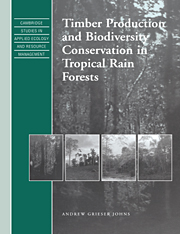Book contents
- Frontmatter
- Contents
- Foreword
- Preface
- Explanatory note
- 1 The issues
- 2 The history and development of tropical forestry
- 3 Changes in the physical environment
- 4 Forest regeneration and gap dynamics
- 5 Responses of individual animal species
- 6 Responses of species assemblages
- 7 Using ecological data in forest management planning
- 8 Intervention to maintain biodiversity
- 9 Field procedures
- 10 The future
- References
- Subject index
2 - The history and development of tropical forestry
Published online by Cambridge University Press: 04 December 2009
- Frontmatter
- Contents
- Foreword
- Preface
- Explanatory note
- 1 The issues
- 2 The history and development of tropical forestry
- 3 Changes in the physical environment
- 4 Forest regeneration and gap dynamics
- 5 Responses of individual animal species
- 6 Responses of species assemblages
- 7 Using ecological data in forest management planning
- 8 Intervention to maintain biodiversity
- 9 Field procedures
- 10 The future
- References
- Subject index
Summary
Historical background
The pre-colonial era
In his Kritias Plato delivered a severe warning of the consequences of continued deforestation in upper Attica. No-one took much notice, with the result that twentieth century Greek foresters are still trying to reforest unproductive land which was degraded as long ago as the third century BC. The importance of maintaining forests is commonly realized only in retrospect.
It is commonly accepted that people moved into tropical forests only comparatively recently: perhaps as long as 40 000 years ago in South-East Asia and the Pacific, but only 10 000 years ago in the Neotropics and 3000 years ago in Africa. The descendants of these people are today among the oldest cultural groups on Earth (e.g. the Onge and Jarawa tribes of the South Andaman Islands, who still lack the knowledge to make fire). Many have complex relationships with the tropical forest based on sustainable use of its various resources and made possible by their very low population densities.
Tree-felling dates back to the advent of flint axes. Throughout history trees have been selected for qualities suitable to construction of houses, canoes or cultural artifacts, or for medicinal properties of their wood. Commercial harvesting dates back at least 2000 years, when the cedars of Cyprus and Lebanon were the first targets of the emerging timber industries of ancient Europe (Meiggs 1982). (Even by this time the cedars had been heavily felled: Noah's ark is recorded as having been built of Cyprus timbers, and Solomon's temple lined with boards from Lebanon.)
Tropical forest silvicultural practices also date back about 2000 years in Java and southern China.
- Type
- Chapter
- Information
- Publisher: Cambridge University PressPrint publication year: 1997



